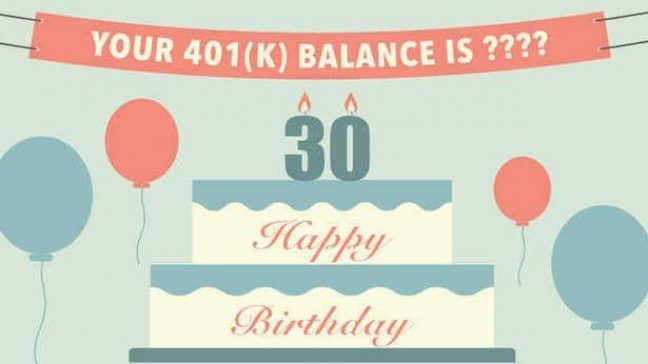How much should be in your 401(k) at 30, 40, 50, etc? What about other retirement accounts? These are good questions.
I’ll try to answer them in this article, but I should warn you: Personal finance is personal.
The more you can contribute to your 401(k), and the sooner you can start, the better. But everybody’s situation is different. Don’t beat yourself up if you feel “behind” in the retirement game … remember, you can’t change yesterday but you can take action today and change tomorrow.
What’s Ahead:
How much should you contribute to your 401(k)?
401(k) and 403(b) contribution limits
In 2023, savers age 49 and under can legally contribute $22,500. Savers who are 50 years or older can make an additional $7,500 “catch up” contribution, for a total annual 401(k) contribution of $30,000 a year.
Okay, done laughing? If the idea of contributing $22,500 a year doesn’t make you laugh, well, great! The rest of us need to find a contribution amount that’s going to accelerate our retirement savings but not cause us to start bouncing checks or going into debt.
The first questions to ask are:
- Does your employer match contributions?
- If so, up to what percentage?
Many employers will kick in a little extra towards your retirement plan. (A common scenario is they’ll match half of what you contribute up to a maximum of 6% of your salary.) If this is the case, then you want to AT LEAST contribute the maximum amount they’ll match. If you don’t, it’s like turning down part of your salary.
Here are some guidelines:
How much should you contribute to your 401(k)?
| Level | Contributions |
|---|---|
| 1 (No employer match) | 5% of salary |
| 1 (With employer match) | Max % employer will match |
| 2 | Max % employer will match plus Roth IRA |
| 3 | Roth IRA plus 10% of salary |
| 4 | Roth IRA plus 15% of salary |
| Maximum | Roth IRA plus annual 401(k) maximum |
Make retirement contributions as aggressively as you comfortably can. Hit Level 1, then step up only after you’ve paid off high-interest credit card debt and saved $5,000-$10,000 for emergencies. Balance 401(k) contributions made with pretax dollars with a Roth IRA, which will provide income that’s tax-free at retirement.
Related: The Roth IRA: Why You (Definitely) Need One
How much should you have in your 401(k) by 30?
So how much should you have saved for retirement before your 30th birthday?
Assuming you have been working since you were 22 or 23, at 30, a great target is to have a 401(k) or IRA equal to about one year’s salary.
For example, if you make $40,000 a year, you could try to have $40,000 saved for retirement. (And if you did save $40,000 before turning 30 and never added another dime, you could have as much as $600k by age 65 with an 8% annual return).
Related: If you still don’t believe in the power of compound interest, you have to see this
That said, don’t freak out if your retirement saving isn’t on this level yet. The sooner you start, the better. But if you start at 30 and don’t plan on retiring until you’re 65, that still gives your money plenty of time to earn interest.
Use this calculator to estimate what your 401(k) balance would be at retirement, based on your personal financial status:
No two investors are alike, especially beginning investors. Your starting salary range and the number of years you have been working are going to be much bigger factors in determining your retirement savings balance at 30 than they will be at 40 or 50, when you will have had additional years to make catch-up contributions or adjust your portfolio as necessary.
Don’t beat yourself up if you can’t save that much money in your 401(k) by 30
There are a couple of good reasons some twentysomethings don’t start putting away for retirement immediately:
- You’re in grad school
- You’re battling big debts
If you’re a student, it’s unlikely you’ll have extra money to tuck away for retirement. And that’s okay, because your education will hopefully increase your lifelong earning potential.
If you’ve got high-interest credit card debt, your top priority should be to pay that down. Debt interest rates could crush even the best retirement account returns, so it’s best to use extra funds to dispatch credit card balances quickly.
The one exception? If your employer matches 401(k) contributions. In this case, contribute the maximum percentage your employer will match, then increase retirement savings after your debt is gone.
Here’s an example of how you could have a year’s worth of salary saved in your 401(k) by age 30
Here are our assumptions:
- You start work at 22
- You can immediately contribute to a 401(k)
- Your employer will match 50% of your contributions up to a maximum of 6% of your salary
- Your investments get an 8% average return
- You get annual raises of 3%
With these assumptions, you’ll need to contribute about 9% of your salary (including your contributions and your employer match) every year to reach this goal. Here are year-by-year totals:
How To Save A Year’s Worth Of Salary In Your 401(k) By Age 30
| Age | Salary | Your 6% Contribution | 3% Employer Match | Total Contributions | Year-End 401(k) Balance |
|---|---|---|---|---|---|
| 22 | $30,000 | $1,800 | $900 | $2,700 | $2,889 |
| 23 | $30,900 | $1,854 | $927 | $2,781 | $6,123.6 |
| 24 | $31,827 | $1,910 | $955 | $2,864 | $9,707.07 |
| 25 | $32,781 | $1,967 | $983 | $2,950 | $13,670.03 |
| 26 | $33,765 | $2,026 | $1,013 | $3,039 | $18,045.62 |
| 27 | $34,778 | $2,087 | $1,043 | $3,130 | $22,869.71 |
| 28 | $35,822 | $2,149 | $1,075 | $3,224 | $28,181.14 |
| 29 | $36,896 | $2,214 | $1,107 | $3,321 | $34,021.95 |
| 30 | $38,003 | $2,280 | $1,140 | $3,420 | $40,437.6 |
But what if you don’t stay at the same job? Here’s how to factor in irregular income and raises
Today, many twentysomethings will work several jobs before turning 30. If this is you, it means your income will fluctuate considerably.
It’s also possible that your salary could double between the time you start working and your 30th birthday. In these cases, set an absolute 401(k) savings goal for the time you turn 30 rather than using your annual earnings as a guide. (Also, be sure to consider the impact of vesting schedules on employer-matched retirement funds).
Rollover 401(k)s into IRAs when you leave jobs and stay on top of your investments. Keep them simple, like index funds and target-date funds, but make sure they’re aggressive.
Finally, consider opening a Roth IRA and contributing as much as you can (up to the 2016 limit of $5,500) to supplement your 401(k). Unlike your 401(k), contributions to a Roth IRA are made with post-tax dollars, but once you retire the withdrawals are tax-free.
Related: Where To Invest: 401k, IRA Or Both?
My rule of thumb is that your contributions should be just large enough to feel uncomfortable. Think about what you could contribute. If you say, “I wouldn’t miss another $100 a month,” then consider going higher until you say “that might get a little tight.” Pull back 5% or 10% from that discomfort zone, and invest away!
The quality of your 401(k)—and the funds in it—matters a lot
Although it’s always better to save more, you can’t overlook how you’re investing your hard-earned dollars.
All 401(k) plans are not created equal. And though 401(k)s have a lot of upsides—high tax-advantaged contribution limits and employer matches — they have negatives, too. The biggest complaint about 401(k) plans is a lack of investment choices.
The companies that administer 401(k)s choose the funds you can invest in. Depending on your employer and your 401(k) administrator, you may not have many funds to choose from and/or the available funds will have higher fees than you could get if you were investing on your own.
This is the biggest reason we recommend opening an IRA, whether it’s to:
- Invest funds after taking advantage of your employer’s match or
- Rollover an old 401(k) as soon as you leave a job.
In an IRA, you can find more investment options with lower costs.
Related: Best Investment Accounts For Young Investors
Not long ago, you had two options: Give up 1% of your annual assets for a professional wealth manager to handle your investments—or figure it out on your own.
Fortunately, there are new, powerful tools out there that can give you free insights into whether you’re investing in the right areas within your 401(k) and IRAs. Personal Capital is a free app that creates easy-to-understand visuals of the investments you own in your 401(k), IRA, and other investment accounts. It then provides recommendations for how to rebalance your portfolio for maximum results and reduce expenses.
Summary
I hope this post was helpful in some way. I know a lot of people are searching for a concrete answer, like “If you’re X years old and earn $Y, contribute $Z.”
Unfortunately, it’s not that easy.
I can tell you one thing, however. Everybody should do the following three things:
- Take advantage of employer matching
- Pay off high-interest credit card debt
- Start a Roth IRA to save on taxes later in life
If you’re looking to take action today, check out our recommendations for the best investment accounts for young investors or at least giving your 401(k) a free checkup using Personal Capital’s portfolio and 401(k) fee analyzer.
Blooom is a 401k optimization tool. blooom works on 401(k) accounts to help you identity low-cost funds and ensure your account is allocated correctly for your risk tolerance and retirement age. Get a free 401(k) analysis from Blooom or read our Blooom review. Right now you can also get $15 off your first year of Blooom with code SMART15.





